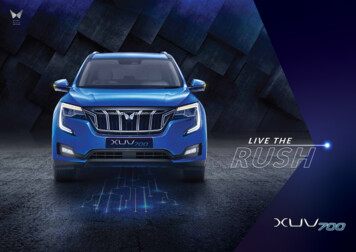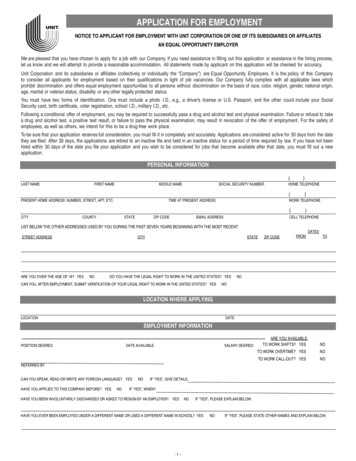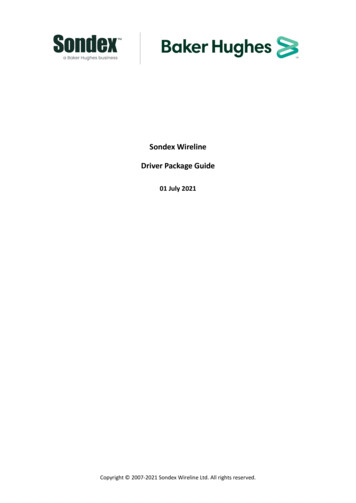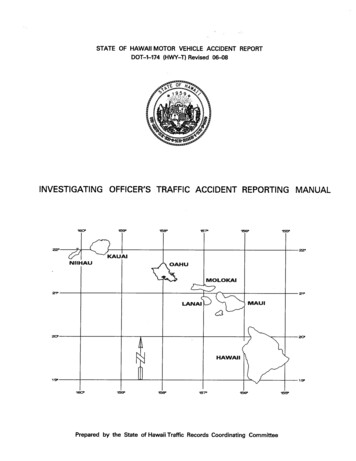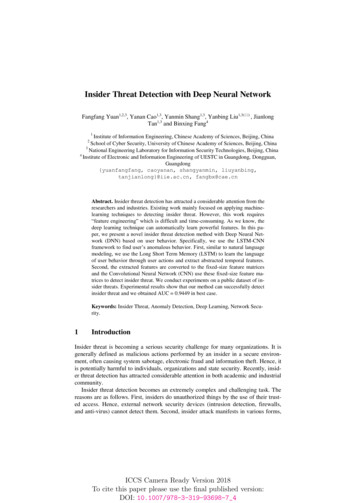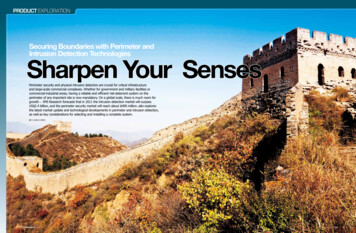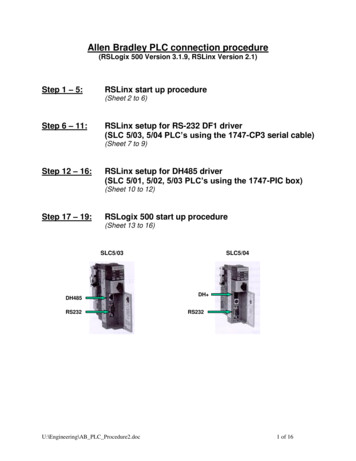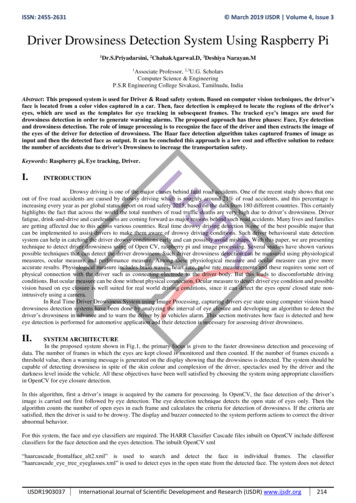
Transcription
ISSN: 2455-2631 March 2019 IJSDR Volume 4, Issue 3Driver Drowsiness Detection System Using Raspberry Pi1Dr.S.Priyadarsini, 2ChahakAgarwal.D, 3Deshiya Narayan.M1Associate Professor, 2,3U.G. ScholarsComputer Science & EngineeringP.S.R Engineering College Sivakasi, Tamilnadu, IndiaAbstract: This proposed system is used for Driver & Road safety system. Based on computer vision techniques, the driver’sface is located from a color video captured in a car. Then, face detection is employed to locate the regions of the driver’seyes, which are used as the templates for eye tracking in subsequent frames. The tracked eye’s images are used fordrowsiness detection in order to generate warning alarms. The proposed approach has three phases: Face, Eye detectionand drowsiness detection. The role of image processing is to recognize the face of the driver and then extracts the image ofthe eyes of the driver for detection of drowsiness. The Haar face detection algorithm takes captured frames of image asinput and then the detected face as output. It can be concluded this approach is a low cost and effective solution to reducethe number of accidents due to driver's Drowsiness to increase the transportation safety.Keywords: Raspberry pi, Eye tracking, Driver.I.INTRODUCTIONDrowsy driving is one of the major causes behind fatal road accidents. One of the recent study shows that oneout of five road accidents are caused by drowsy driving which is roughly around 21% of road accidents, and this percentage isincreasing every year as per global status report on road safety 2015, based on the data from 180 different countries. This certainlyhighlights the fact that across the world the total numbers of road traffic deaths are very high due to driver’s drowsiness. Driverfatigue, drink-and-drive and carelessness are coming forward as major reasons behind such road accidents. Many lives and familiesare getting affected due to this across various countries. Real time drowsy driving detection is one of the best possible major thatcan be implemented to assist drivers to make them aware of drowsy driving conditions. Such driver behavioural state detectionsystem can help in catching the driver drowsy conditions early and can possibly avoid mishaps. With this paper, we are presentingtechnique to detect driver drowsiness using of Open CV, raspberry pi and image processing. Several studies have shown variouspossible techniques that can detect the driver drowsiness. Such driver drowsiness detection can be measured using physiologicalmeasures, ocular measure and performance measure. Among these physiological measure and ocular measure can give moreaccurate results. Physiological measure includes brain waves, heart rate, pulse rate measurements and these requires some sort ofphysical connection with the driver such as connecting electrode to the driver body. But this leads to discomfortable drivingconditions. But ocular measure can be done without physical connection. Ocular measure to detect driver eye condition and possiblevision based on eye closure is well suited for real world driving conditions, since it can detect the eyes open/ closed state nonintrusively using a camera.In Real Time Driver Drowsiness System using Image Processing, capturing drivers eye state using computer vision baseddrowsiness detection systems have been done by analyzing the interval of eye closure and developing an algorithm to detect thedriver’s drowsiness in advance and to warn the driver by in vehicles alarm. This section motivates how face is detected and howeye detection is performed for automotive application and their detection is necessary for assessing driver drowsiness.II.SYSTEM ARCHITECTUREIn the proposed system shown in Fig.1, the primary focus is given to the faster drowsiness detection and processing ofdata. The number of frames in which the eyes are kept closed is monitored and then counted. If the number of frames exceeds athreshold value, then a warning message is generated on the display showing that the drowsiness is detected. The system should becapable of detecting drowsiness in spite of the skin colour and complexion of the driver, spectacles used by the driver and thedarkness level inside the vehicle. All these objectives have been well satisfied by choosing the system using appropriate classifiersin OpenCV for eye closure detection.In this algorithm, first a driver’s image is acquired by the camera for processing. In OpenCV, the face detection of the driver’simage is carried out first followed by eye detection. The eye detection technique detects the open state of eyes only. Then thealgorithm counts the number of open eyes in each frame and calculates the criteria for detection of drowsiness. If the criteria aresatisfied, then the driver is said to be drowsy. The display and buzzer connected to the system perform actions to correct the driverabnormal behavior.For this system, the face and eye classifiers are required. The HARR Classifier Cascade files inbuilt on OpenCV include differentclassifiers for the face detection and the eyes detection. The inbuilt OpenCV xml“haarcascade frontalface alt2.xml” is used to search and detect the face in individual frames. The classifier“haarcascade eye tree eyeglasses.xml” is used to detect eyes in the open state from the detected face. The system does not detectIJSDR1903037International Journal of Scientific Development and Research (IJSDR) www.ijsdr.org214
ISSN: 2455-2631 March 2019 IJSDR Volume 4, Issue 3in the closed state of the eyes. The face detection and open eye detection have been carried out on each frame of the driver’s facialimage acquired from the camera. The variable Eyestotal is assigned to store the number of open eyes (0, 1 and 2) detected in eachframe. The variable Drowsycount is assigned for storing the number of successive frames in which the eyes have been Drowsycountgets incremented when Eyestotal 2. For an eye blink, Drowsycount value gets incremented to 1. If the eyeblink occurs for morethan 4 frames, i.e. Drowsycount 4, then the criterion for drowsiness is satisfied.Fig:1 System Diagram For Proposed MethodThe proposed system comprises of three phases.Face Detection:The proposed system will start by capturing the video frames one by one. OpenCV provides extensive supportfor processing live videos. The system will Sdetect the face in the frame image for each frame. This system uses Viola-Jones objectdetector which is a machine learning approach for visual object detection (Paul Viola, 2004 and Paul Viola, 2001). This is achievedby making use of the Haar algorithm for face detection. Haarcascade is a well-known robust feature-based algorithm that can detectthe face image efficiently. With the use of uses of cascade of stages, Haar algorithm able to remove the candidates that are nonface. And each stage consists of combination of different Haar features and each feature in turn is classified by a Haar featureclassifier. The inbuilt OpenCV xml “haarcascade frontalface alt2.xml” file is used to search and detect the face in individualframes. This file contains a number of features of the face and constructed by using a number of positive and negative samples.First load the cascade file then pass the acquired frame to an edge detection function, which detects all the possible objects ofdifferent sizes in the frame. Since the face of the driver occupies a large part of the image, instead of detecting objects of all possiblesizes, specify the edge detector to detect only objects of a particular size i.e. for face region. Next, the output the edge detector isstored and this output is compared with the cascade file to identify the face in the frame. The output of this module is a frame withface detected in it. Only disadvantage in Haar algorithm is that it cannot extrapolate and does not work appropriately when the faceis not in front of the camera axis. Once the face detection function has detected the face of the driver, the eyes detection functiontries to detect the driver's eyes.Eye detection:Once the face detection function has detected the face of the driver, the eyes detection function tries to detect the automobiledriver's eyes. After face detection find eye region by considering eyes are present only in upper part of the face and from top edgeIJSDR1903037International Journal of Scientific Development and Research (IJSDR) www.ijsdr.org215
ISSN: 2455-2631 March 2019 IJSDR Volume 4, Issue 3of the face, extract eyes Region of Interest (ROI) by cropping mouth and hair, we mark it the region of interest. By considering theregion of interest it is possible to reduce the amount of processing required and also speeds up the processing for getting exact eyes.After the region of interest is marked, the edge detection technique is applied only on the region of interest .Then search for eyes inROI; Circular Hough Transformation is used here to find shape of eyes (Rhody Chester, 2005). The main advantage of the Houghtransform technique is that it is liberal to gaps in feature boundary descriptions and is relatively unaffected by image noise, unlikeedge detectors. The OpenCV function HoughCircles () is used to detect circles in an eye image. CHT ensure that at most two eyesfound. With the eye detection technique we will only be able to detect the open state of eyes.Drowsiness Detection:After getting eyes the algorithm then counts the number of open eyes form each frame and determines the drowsiness. If the criteriaare satisfied, then the driver is said to be drowsy. The buzzer connected to the system performs actions to correct the driver abnormalbehaviour. For this system, the eye and the face classifiers are required. The HARR Classifier Cascade files built-in there with theOpen CV contains different classifiers for the face and eye detection. The inbuilt Open CV xml“haarcascade frontalface alt2.xml”and function “Houghcircles ()” is used to search and detect the face followed by individualframes. The face detection and open eye detection have been carried out on each frame of the driver’s captured facial image. Thevariable Eyes total is assigned to store the number of open eyes found in each frame. A variable will store the number of successiveframes in which the eyes found to be closed with the values like 0, 1, 2, 3 etc. Initially, this variable is set to 0.When both theeyes are open, and then Drowsy count will be 0. Drowsy count will increase when Eyes total 2. For an eye blink, Drowsy countvalue is raised by 1. If the eye blinks in more than 4 frames, i.e. variable count is greater than or equal to 4, then the condition fordrowsiness is met and an alarm will be signalled at real time.RASSPBERRY PI 3 MODEL BRaspberry Pi is a credit card sized single-board computer. It has 5 models. Model A, Model A , Model B, Model B , Generation2 Model B. Model A has 256Mb RAM, one USB port and no network connection. Model A has 256Mb RAM, one USB port andnetwork connection. Model B has 512Mb RAM, 2 USB ports and an Ethernet port. Model B has 512Mb RAM, four USB ports,Ethernet port and HDMI and camera interface slot. Generation 2 Model B also has 4 USB ports, 1 GB RAM, 2 camera interfaceand 1HDMI interface. We implemented raspberry pi tablet using Model B . IT has a Broadcom BCM2835 system on chip whichinclude an ARM1176JZF-S 700 MHz processor, Video Core IV GPU, and an SD card. The GPU is capable of Blu-ray qualityplayback, using H.264 at 40MBits/s. It has a fast 3D core accessed using the supplied Open GL ES2.0 and Open VG libraries. Thechip specifically provides HDMI and there is no VGA support. The foundation provides Debian and Arch Linux ARM distributionsand also Python as the main programming language, with the support for BBC BASIC, C and Perl.Fig 2 RASSPBERRY PI 3 MODEL BVISION TO RASSPBERRY PPIThe Raspberry Pi Camera Board plugs directly into the CSI connector on the Raspberry Pi. It's able to deliver acrystal clear 5MP resolution image, or 1080p HD video recording at 30fps The Raspberry Pi Camera Board features a 5MP(2592 1944 pixels) Omni vision 5647 sensor in a fixed focus module. The module attaches to Raspberry Pi, by way of a 15 PinRibbon Cable, to the dedicated 15-pin MIPI Camera Serial Interface (CSI), which was designed especially for interfacing to camera.INTERFACING CAMERAThe following are steps to be used for interfacing the camera:1.2.Power up raspberry pi and login as “pi" and password as “raspberry”.At the command prompt enter the following command as “sudo raspi-config” and navigate to “ENABLE”.IJSDR1903037International Journal of Scientific Development and Research (IJSDR) www.ijsdr.org216
ISSN: 2455-2631 March 2019 IJSDR Volume 4, Issue 3CAPTURING IMAGE“Raspistill” is the command line tool for capturing still photographs with the camera module. With thecamera module connected and enabled, enter the following command in the LX Terminal to take a picture:“raspistill -o cam.jpg”III RESULTS:The proposed drowsiness detection system detects the drowsiness of the driver when the eyes are closed for 4frames or more (i.e., more than 2 seconds). The detection system differentiates the normal eye blink and drowsiness. The system isnon intrusive and can be easily equipped with any vehicle.The Visual Studio Express simulation results of the drowsiness system are illustrated in the following figures. In Fig.3, the normalstate of the driver is shown in which the open eyes are detected. In Fig.3, the driver eyes have been kept closed for successive 4frames. The system is capable of detecting drowsiness in spite of the spectacles worn by the driver. The condition of the driverwearing spectacles is shown in Fig 3. In normal driving conditions, the open eyes are detected. The drowsiness is detected whenthe eyes have been kept closed for successive 4 frames as shown in Fig.3Fig 4 FACE DETECTIONIn normal driving condition, both the eyes are open. Hence the system could detect the open eyes. Open eyes detection wasillustrated by drawing rectangles around the eyes as shown in Fig. 4 In the drowsiness condition, the eyes get closed.Fig 5 EYE DETECTIONIn Fig.5, it is shown that for normal driving, the number of open eyes is 2 and the number of successive frames for closed eyes is0. When the eyes are closed in one frame, the number of open eyes becomes 0 and number of closure frames increment by 1. If thiscondition persists for continuous 4 frames and more, the execution window shows drowsiness detected. Also, it calculates theduration for which the eyes have been kept closed. The system is capable to detect drowsiness in the case of closed eyes for morethan 2 seconds.VI CONCLUSION & FUTURE SCOPEThe driver abnormality monitoring system developed is capable of detecting drowsiness, drunken and recklessbehaviours of driver in a short time. The Drowsiness Detection System developed based on eye closure of the driver can differentiatenormal eye blink and drowsiness and detect the drowsiness while driving. The proposed system can prevent the accidents due toIJSDR1903037International Journal of Scientific Development and Research (IJSDR) www.ijsdr.org217
ISSN: 2455-2631 March 2019 IJSDR Volume 4, Issue 3the sleepiness while driving. The system works well even in case of drivers wearing spectacles and even under low light conditionsif the camera delivers better output. Information about the head and eyes position is obtained through various self-developed imageprocessing algorithms. During the monitoring, the system is able to decide if the eyes are opened or closed. When the eyes havebeen closed for too long, a warning signal is issued. Processing judges the driver’s alertness level on the basis of continuous eyeclosures.In future it can implement drowsiness detection system in aircraft in order to alert pilot. The alcoholic sensor is also used for drunk drivers In future it can implement drowsiness detection system in schools and colleges to alert the staffs to find the drowsy studentin class.REFERENCES[1]Rhody Chester, H. F. ‘’Hough Circle Transform‘’, CarlsonCenter for ImagingScience Rochester Institute of Technology October11, 2005[2]Mario I Chacon-Murguia Claudia Prieto-Resendiz,”Detecting Driver Drowsiness-A survey of system designs and technology,”IEEE Consumer Electronics Magazine,pp.107-108,October 2015.[3]Mayank Chauhan, Mukesh Sakle”Study & Analysis of Different Face Detection Techniqes” International Journal of ComputerScience and Information Technologies, Vol. 5 (2) , pp 1615-1618,2014.[4]Paul Viola and Michael j. Jones,” Rapid Object Detection using a Boosted Cascade of Simple Features,” International Journalof Computer Vision 57(2), pp 137–154, 2001.[5]Paul Viola and Michael j. Jones,” Robust Real-Time Face Detection,” International Journal of Computer Vision 57(2), 137–154,2004.[6]“Drowsy Driving,” National Highway Traffic Safety Administration (NHTSA), 01-Feb-2018. [Online]. Available:[7] “Drowsy Driving: Asleep at the Wheel,” Centers for Disease Control and Prevention, 07-Nov-2017.[8] C. C. Liu, S. G. Hosking, and M. G. Lenné, "Predicting driver drowsiness using vehicle measures: Recent insights and futurechallenges," Journal of Safety Research, vol. 40, no. 4, pp. 239-245, 2009.[9] P. M. Forsman, B. J. Vila, R. A. Short, C. G. Mott, and H. P. Van Dongen, "Efficient driver drowsiness detection at moderatelevels of drowsiness," Accident Analysis & Prevention, vol. 50, pp. 341-350, 2013.[10] S. Otmani, T. Pebayle, J. Roge, and A. Muzet, "Effect of driving duration and partial sleep deprivation on subsequent alertnessand performance of car drivers," Physiology & behavior, vol. 84, no. 5, pp. 715-724, 2005.[11] P. Thiffault and J. Bergeron, "Monotony of road environment and driver fatigue: a simulator study," Accident Analysis &Prevention, vol. 35, no. 3, pp. 381-391, 2003.[12] S. H. Fairclough and R. Graham, "Impairment of driving performance caused by sleep deprivation or alcohol: a comparativestudy," Human factors, vol. 41, no. 1, pp. 118-128, 1999.[13] E. Vural, M. Cetin, A. Ercil, G. Littlewort, M. Bartlett, and J. Movellan, "Drowsy driver detection through facial movementanalysis," in International Workshop on Human-Computer Interaction, 2007, pp. 6- 18: Springer.[14] T. P. Nguyen, M. T. Chew and S. Demidenko, "Eye tracking system to detect driver drowsiness," 2015 6th InternationalConference on Automation, Robotics and Applications (ICARA), Queenstown, 2015, pp. 472-477.IJSDR1903037International Journal of Scientific Development and Research (IJSDR) www.ijsdr.org218
RASSPBERRY PI 3 MODEL B Raspberry Pi is a credit card sized single-board computer. It has 5 models. Model A, Model A , Model B, Model B , Generation 2 Model B. Model A has 256Mb RAM, one USB port and no network connection. Model A has 256Mb RAM, one USB port and network connection. Model B has 512Mb RAM, 2 USB ports and an Ethernet port.
